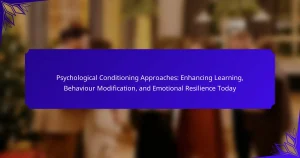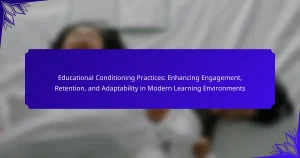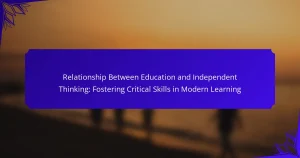Developing effective study habits is essential for lifelong learning and enhancing information retention. Consistent practice and active engagement foster discipline and understanding. Techniques like spaced repetition and self-testing improve memory and recall. Tailoring study methods to individual learning styles can further boost retention and motivation.

What are Effective Study Habits for Lifelong Learning?
Effective study habits for lifelong learning include consistent practice, active engagement, and self-reflection. Establishing a routine fosters discipline and enhances retention. Incorporating techniques like spaced repetition and summarization improves understanding and memory. Setting specific goals and tracking progress can also boost motivation and accountability.
How do Study Habits Impact Learning Retention?
Effective study habits significantly enhance learning retention by promoting active engagement and structured information processing. Techniques such as spaced repetition and self-testing enable deeper understanding and memory consolidation. Research indicates that students who employ these methods retain information longer and perform better academically. Additionally, maintaining a consistent study schedule fosters discipline, reinforcing learning through regular review. Developing personalized strategies tailored to individual learning styles can further optimize retention outcomes.
What are the Key Components of Effective Study Habits?
Effective study habits include time management, active engagement, and regular review. These components enhance retention and foster lifelong learning.
Time management involves creating a structured schedule that allocates specific periods for study and breaks. Active engagement means participating in discussions, teaching concepts to others, and utilizing varied learning resources. Regular review, through spaced repetition, reinforces knowledge and improves long-term retention.
Incorporating these strategies leads to improved academic performance and deeper understanding of the material.
How to Set Specific Learning Goals?
To set specific learning goals, identify clear, measurable objectives that align with your long-term aspirations. Break down larger goals into smaller, achievable tasks to enhance focus and motivation. Use the SMART criteria: Specific, Measurable, Achievable, Relevant, and Time-bound. For example, instead of stating “I want to learn Spanish,” specify “I will complete one lesson of a Spanish course each week.” Regularly review and adjust your goals to maintain progress and adapt to changing needs.
What Role Does Time Management Play?
Time management is crucial for effective study habits, enhancing retention and lifelong learning. It allows learners to allocate specific periods for focused study, reducing procrastination and improving productivity. By prioritizing tasks, students can engage with material more deeply, leading to better understanding and recall. Effective time management techniques, such as the Pomodoro Technique or time blocking, can significantly boost retention rates, making learning more efficient.
How to Create a Distraction-Free Study Environment?
To create a distraction-free study environment, choose a quiet location with minimal interruptions. Ensure adequate lighting and comfortable seating to enhance focus. Organize study materials and eliminate clutter to promote a clear mindset. Consider using noise-canceling headphones or background music to further reduce distractions.

What are the Universal Techniques for Enhanced Retention?
Effective study habits significantly enhance retention. Universal techniques include active recall, spaced repetition, and interleaved practice. Active recall involves retrieving information from memory, reinforcing learning. Spaced repetition optimizes review timing, improving long-term retention. Interleaved practice mixes different subjects or topics, promoting better understanding and adaptability. Implementing these techniques fosters lifelong learning and improves information retention.
How Does Active Learning Improve Retention?
Active learning enhances retention by engaging learners in the material, promoting deeper understanding and memory retention. Techniques such as self-explanation, peer teaching, and active questioning encourage critical thinking and application of knowledge. Research shows that active engagement can improve retention rates by up to 75%. Additionally, incorporating varied learning methods, like discussions and hands-on activities, caters to different learning styles, further solidifying retention.
What are the Benefits of Spaced Repetition?
Spaced repetition enhances long-term retention by optimizing the timing of reviews. This technique leverages the psychological spacing effect, which helps reinforce memory and combat forgetting. Regularly spaced intervals allow learners to review material just before they are likely to forget it, maximizing recall efficiency. Research indicates that spaced repetition can improve learning outcomes significantly compared to traditional study methods, making it a powerful tool for effective study habits.
How Can Mind Mapping Aid in Memory Retention?
Mind mapping enhances memory retention by organizing information visually. This technique encourages active engagement with content, promoting better understanding and recall. By connecting ideas through branches, it creates a structured overview that simplifies complex topics. Research shows that visual aids can increase retention rates by up to 60%. Mind mapping also fosters creativity, allowing learners to explore relationships between concepts. Adopting mind mapping as a study habit can significantly improve lifelong learning outcomes.
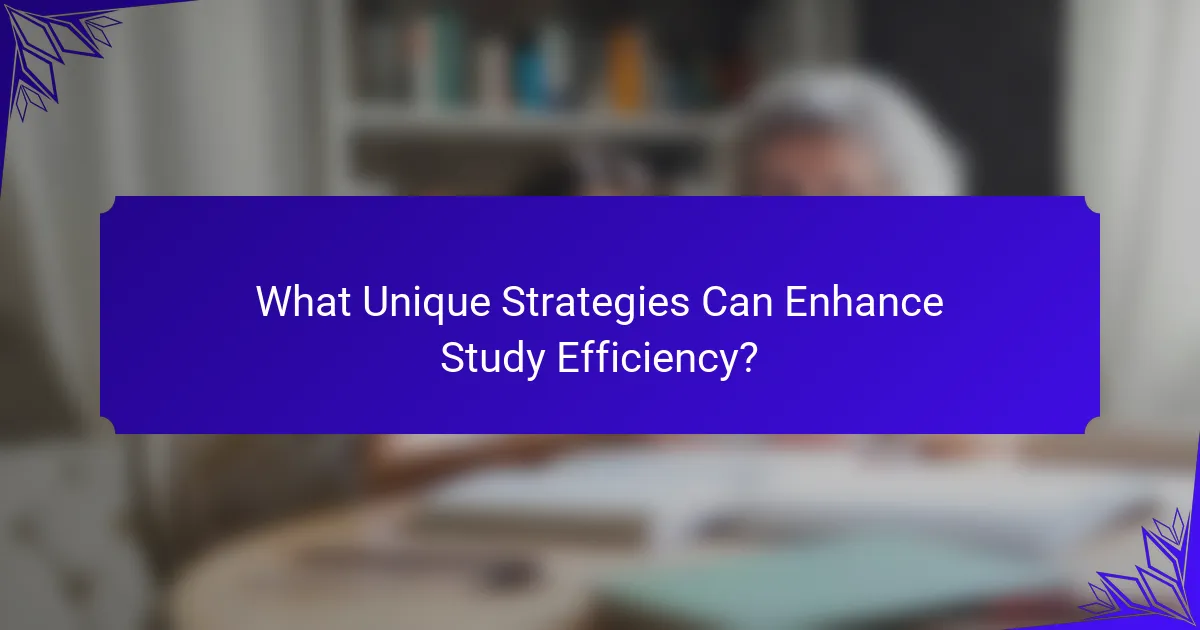
What Unique Strategies Can Enhance Study Efficiency?
To enhance study efficiency, incorporate active learning techniques. These methods, such as summarization and self-testing, significantly improve retention. Research indicates that active engagement can increase information recall by up to 50%. Additionally, employing spaced repetition allows for better long-term retention by revisiting material at intervals. Creating a structured study schedule further optimizes focus and reduces procrastination. Finally, leveraging technology, like educational apps, can provide personalized learning experiences, enhancing overall efficiency.
How to Utilize Technology for Effective Learning?
Utilizing technology effectively enhances learning by integrating tools that support study habits and retention techniques. Incorporate digital resources like educational apps, online courses, and virtual study groups. These platforms foster engagement and provide immediate access to information.
Leverage tools such as note-taking apps and flashcard software to organize content and reinforce memory retention. For example, spaced repetition algorithms in flashcard apps help optimize review sessions.
Additionally, utilize collaborative platforms for group study sessions, which encourage knowledge sharing and diverse perspectives. This interaction can deepen understanding and retention.
Finally, track progress with learning management systems that provide analytics on study habits and performance, allowing for adjustments to improve effectiveness.
What Role Do Study Groups Play in Learning?
Study groups enhance learning by fostering collaboration, accountability, and diverse perspectives. They encourage active engagement, which boosts retention. Research shows that peer discussions can improve understanding by up to 30%. Additionally, study groups provide a unique social aspect, making learning more enjoyable and less isolating. Structured group sessions can lead to better time management and focus, crucial for effective study habits.
How Can Gamification Enhance Study Engagement?
Gamification enhances study engagement by making learning interactive and enjoyable. It incorporates game elements that motivate students, such as points, badges, and challenges. This approach can lead to increased participation and improved retention of information. Studies show that gamified learning environments can boost student motivation by up to 50%. Additionally, gamification encourages collaboration among peers, fostering a supportive learning community. As a result, students are more likely to develop effective study habits that contribute to lifelong learning.

What Rare Techniques Are Worth Exploring?
Exploring rare techniques can significantly enhance study habits and retention. Techniques like spaced repetition, interleaved practice, and retrieval practice stand out for their effectiveness. Spaced repetition involves reviewing material at increasing intervals, promoting long-term retention. Interleaved practice mixes different subjects or topics, enhancing problem-solving skills. Retrieval practice encourages recalling information, strengthening memory pathways. These methods are backed by cognitive science research, demonstrating their unique ability to improve learning outcomes.
How Does the Feynman Technique Foster Understanding?
The Feynman Technique enhances understanding by promoting active engagement with material. This approach encourages learners to explain concepts in simple terms, revealing gaps in knowledge. By breaking down complex ideas, individuals reinforce retention and clarity. This method also fosters curiosity, leading to deeper exploration of subjects. As a result, learners develop a more profound comprehension of topics, making information easier to recall in the future.
What is the Role of Interleaved Practice in Learning?
Interleaved practice enhances learning by mixing different subjects or skills during study sessions. This approach improves retention and understanding by promoting connections between concepts. Research shows that interleaved practice leads to better long-term retention compared to blocked practice, where similar topics are studied in isolation. By varying the material, learners develop adaptive expertise, which allows for improved problem-solving in real-world scenarios. This technique is particularly effective in subjects like mathematics and language learning, where applying knowledge across contexts is vital.
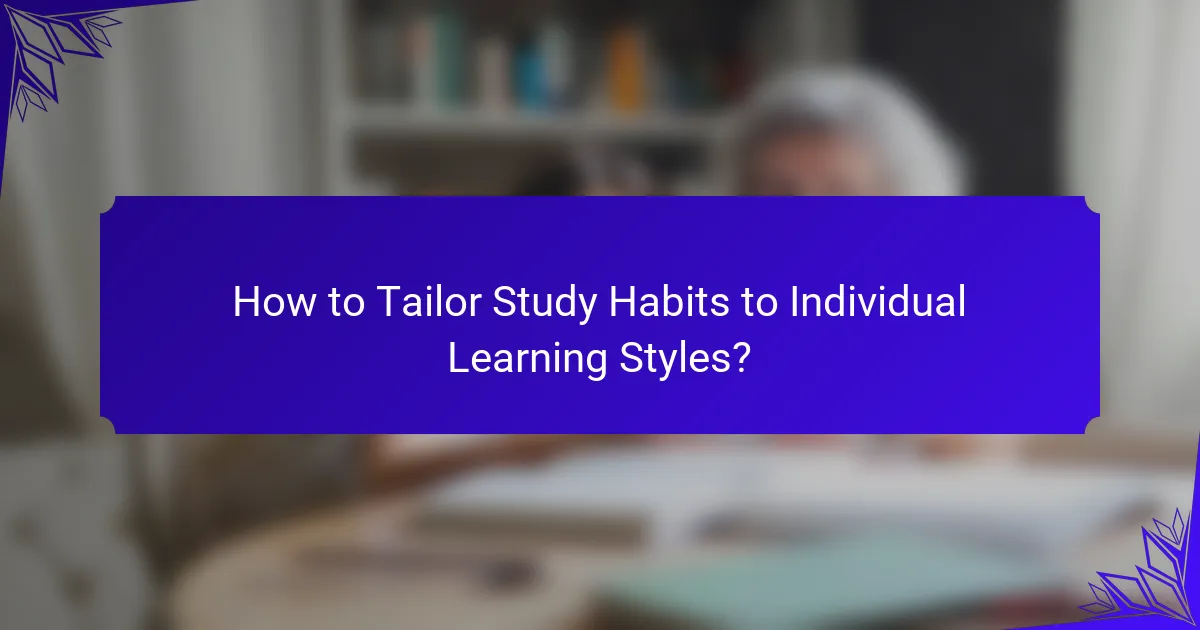
How to Tailor Study Habits to Individual Learning Styles?
Tailoring study habits to individual learning styles enhances retention and engagement. Identify whether you are a visual, auditory, or kinesthetic learner. Visual learners benefit from diagrams and charts, while auditory learners excel with discussions and lectures. Kinesthetic learners retain information better through hands-on activities. Adapt your study techniques to align with your preferred style for optimal results. For example, visual learners may use color-coded notes, auditory learners might record lectures, and kinesthetic learners could engage in role-playing exercises.
What are the Different Learning Styles?
Different learning styles include visual, auditory, reading/writing, and kinesthetic. Understanding these styles enhances study habits and retention techniques.
Visual learners benefit from diagrams and charts, while auditory learners excel with lectures and discussions. Reading/writing learners thrive on written material, and kinesthetic learners grasp concepts through hands-on activities.
Adapting study strategies to match these styles can improve engagement and retention. For example, incorporating visuals for visual learners or interactive tasks for kinesthetic learners can lead to more effective learning experiences.
Research indicates that tailoring study approaches to individual learning styles can significantly enhance information retention and application.
How to Identify Your Learning Style?
To identify your learning style, reflect on how you best absorb and process information. Consider whether you prefer visual aids, auditory explanations, or hands-on experiences.
Visual learners benefit from diagrams and charts, while auditory learners excel with lectures and discussions. Kinesthetic learners thrive with practical activities. Understanding your learning style enhances study habits and retention techniques, fostering lifelong learning.
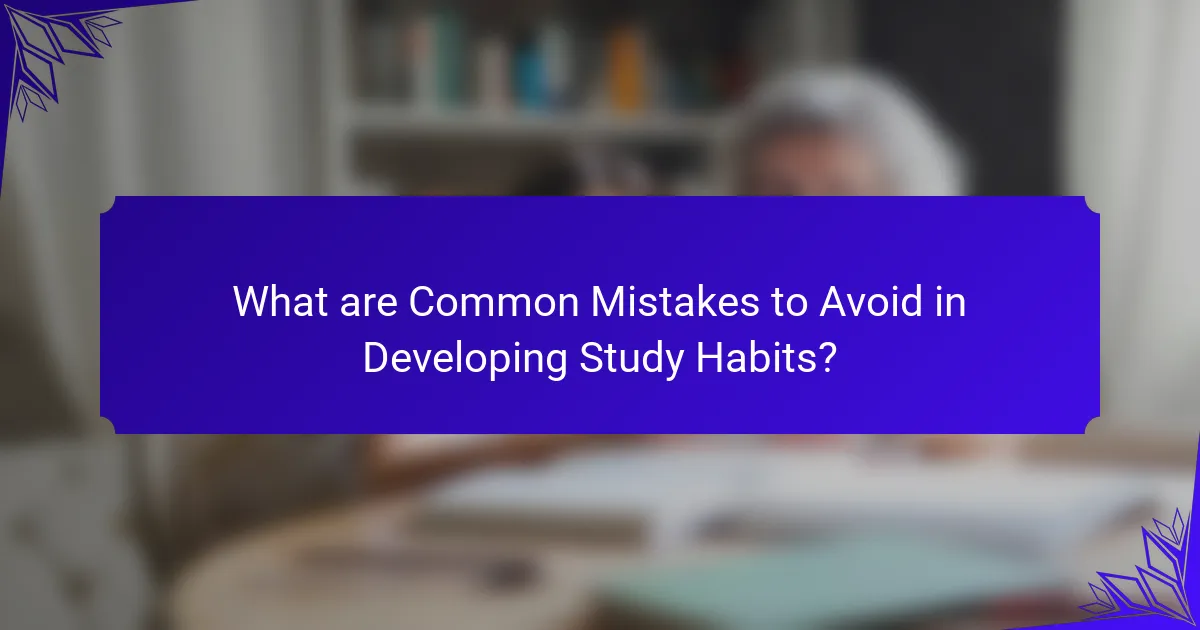
What are Common Mistakes to Avoid in Developing Study Habits?
To develop effective study habits, avoid these common mistakes: procrastination, lack of organization, ineffective study techniques, and neglecting breaks. Procrastination hinders progress, while disorganization leads to wasted time. Using ineffective techniques, such as cramming, reduces retention. Finally, neglecting breaks causes burnout, impairing learning. Focus on creating a structured study schedule, employing active learning strategies, and ensuring regular breaks to enhance retention and lifelong learning.
How to Recognize and Avoid Procrastination?
To recognize and avoid procrastination, identify triggers and set clear goals. Break tasks into smaller, manageable steps to reduce overwhelm. Establish a structured routine and remove distractions from your environment. Use time management techniques, such as the Pomodoro Technique, to maintain focus. Regularly review your progress to stay motivated and accountable.
What are the Pitfalls of Cramming?
Cramming can lead to poor retention and increased stress. It often results in superficial learning, where information is memorized without understanding. This approach can hinder long-term knowledge application and critical thinking skills. Additionally, cramming may disrupt sleep patterns, negatively affecting cognitive function and overall well-being.
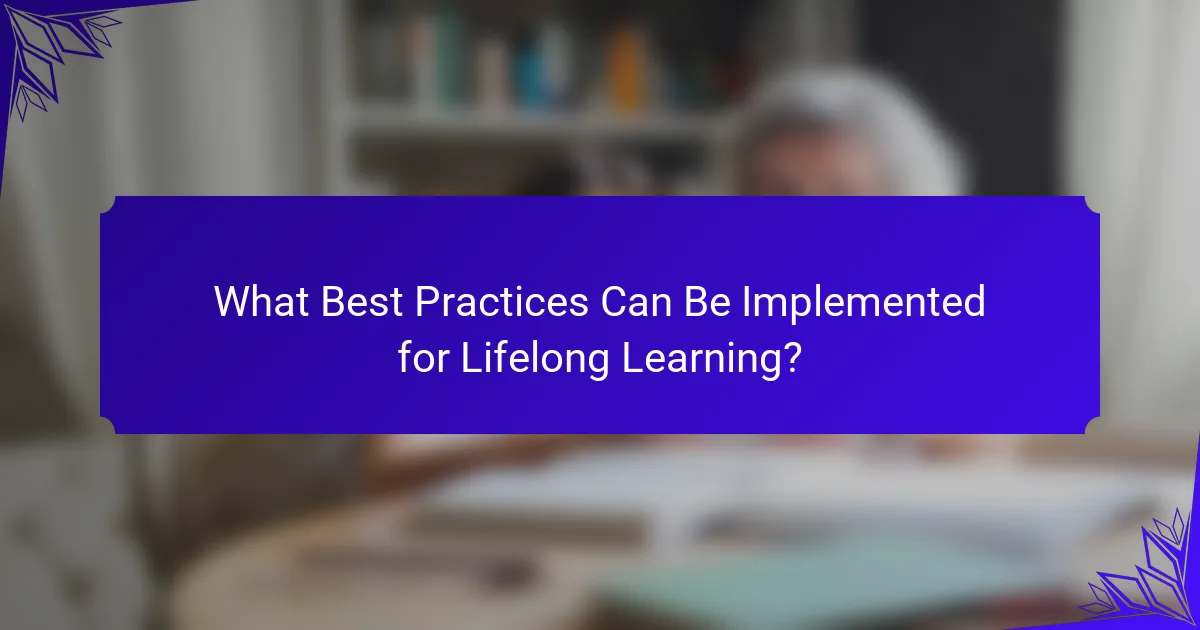
What Best Practices Can Be Implemented for Lifelong Learning?
To develop effective study habits for lifelong learning, prioritize consistency, active engagement, and reflection. Establish a routine that incorporates regular study sessions, focusing on understanding rather than memorization. Utilize techniques like spaced repetition and self-testing to enhance retention. Incorporate diverse resources such as books, podcasts, and online courses to broaden perspectives. Set specific goals to measure progress, and reflect on learning experiences to identify areas for improvement.
How to Develop a Consistent Study Routine?
To develop a consistent study routine, prioritize creating a structured schedule that allocates specific time blocks for studying. Identify your peak focus times and integrate breaks to enhance retention. Utilize techniques like active recall and spaced repetition to reinforce learning. Regularly assess your progress and adjust your methods to maintain engagement and effectiveness.
What are the Benefits of Reflective Learning?
Reflective learning enhances critical thinking, self-awareness, and retention. It promotes deeper understanding by encouraging learners to analyze experiences. This process leads to improved problem-solving and adaptability in various contexts. Regular practice of reflective learning fosters lifelong learning habits, ensuring knowledge is continually updated and retained effectively.
How to Continuously Assess and Adapt Your Study Techniques?
To continuously assess and adapt your study techniques, regularly evaluate your progress and adjust methods accordingly. Track your retention rates and comprehension levels to identify effective strategies. Incorporate diverse learning styles, such as visual aids or practice tests, to enhance engagement. Seek feedback from peers or mentors to gain new perspectives. Periodically revisit and refine your goals to stay aligned with your learning objectives.
